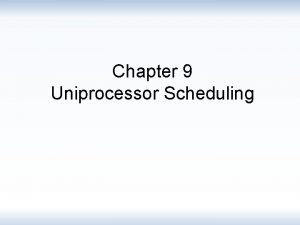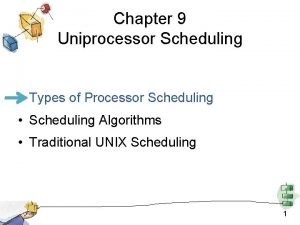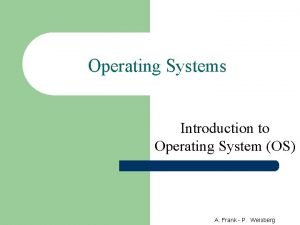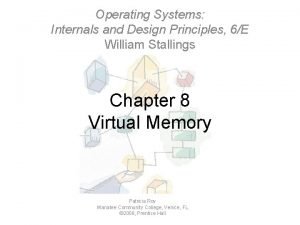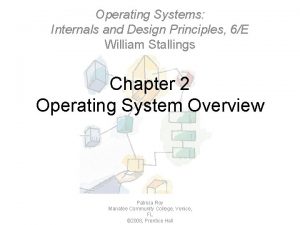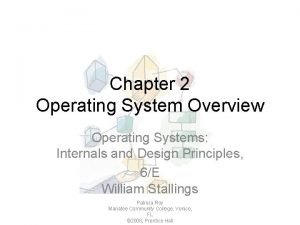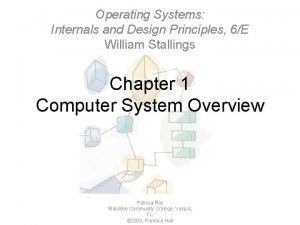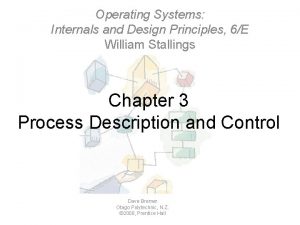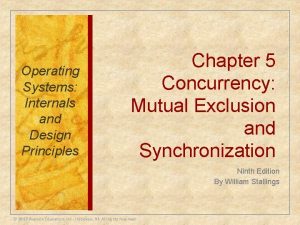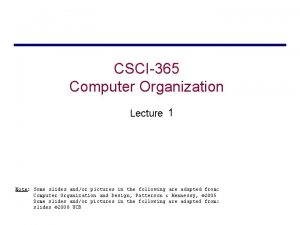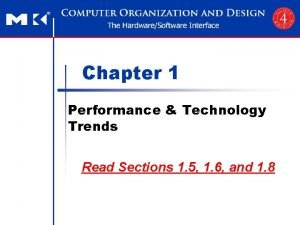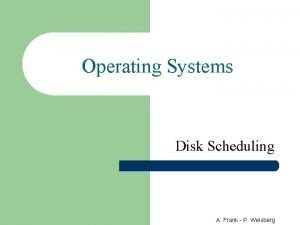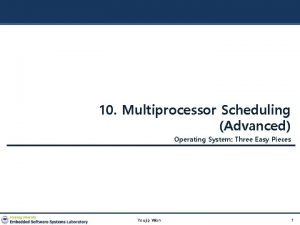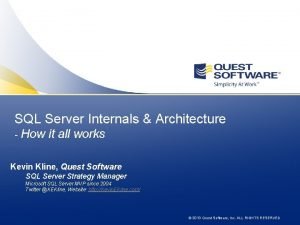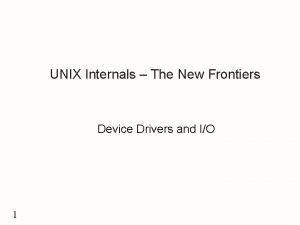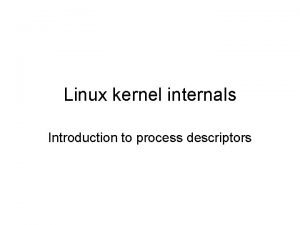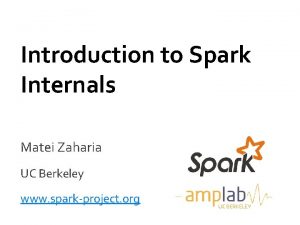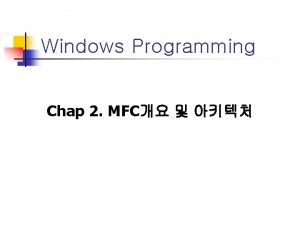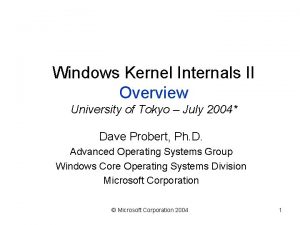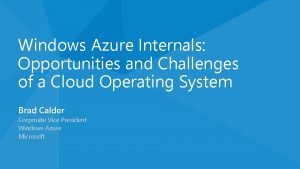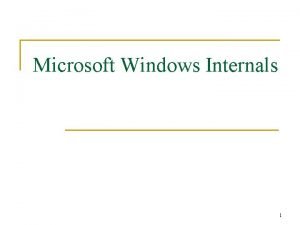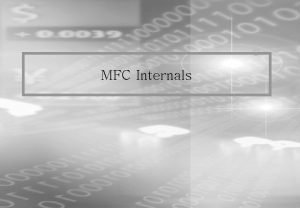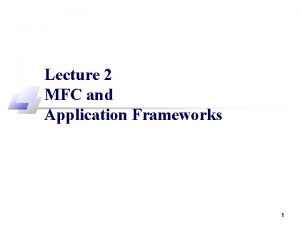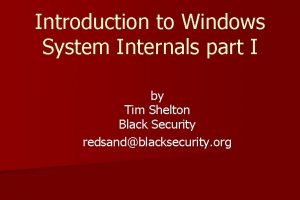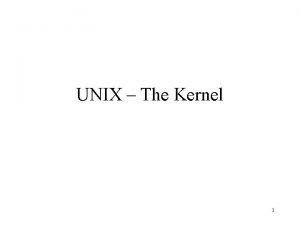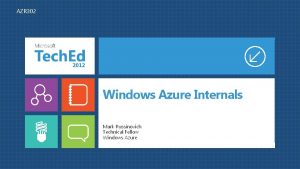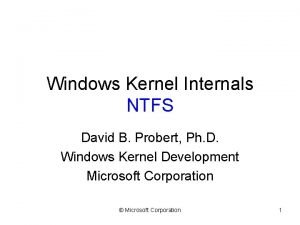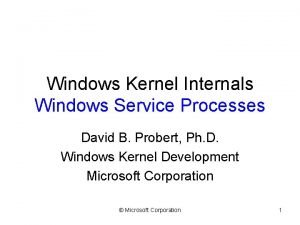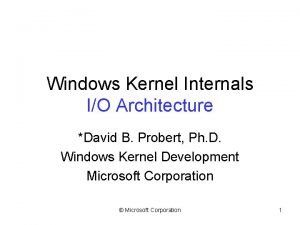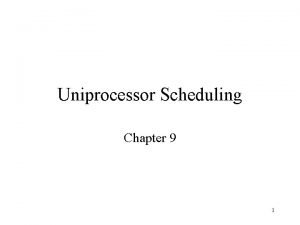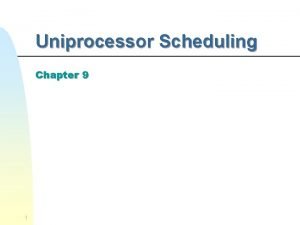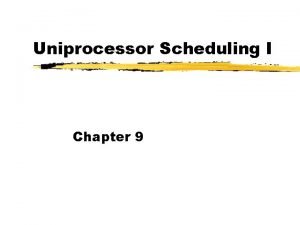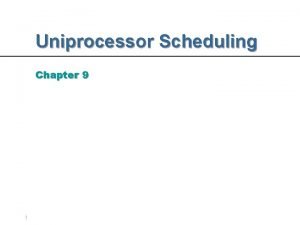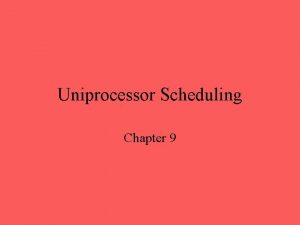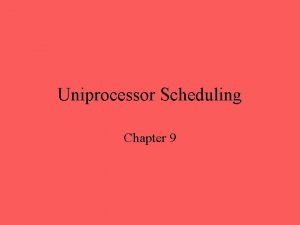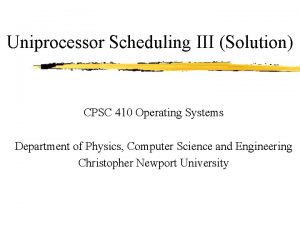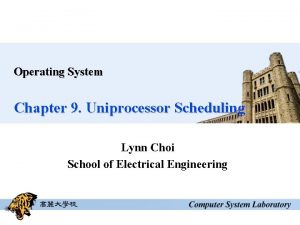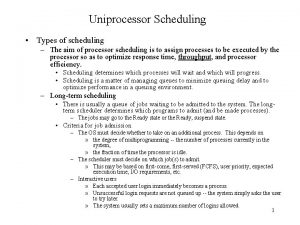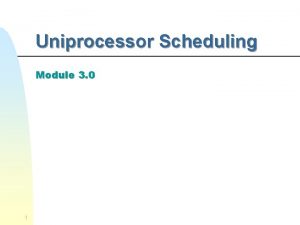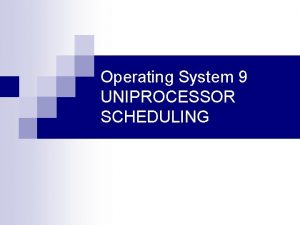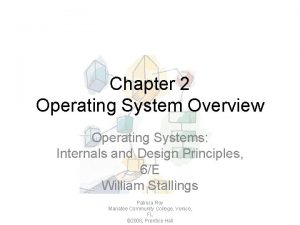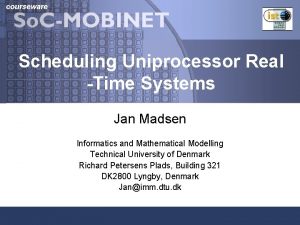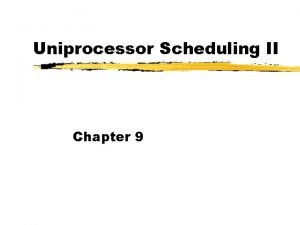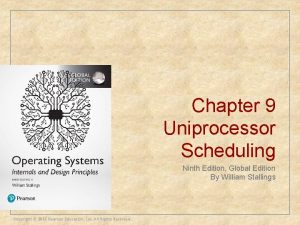Uniprocessor Scheduling Chapter 9 Operating Systems Internals and




































- Slides: 36

Uniprocessor Scheduling Chapter 9 Operating Systems: Internals and Design Principles, 6/E William Stallings Patricia Roy Manatee Community College, Venice, FL © 2008, Prentice Hall

CPU- and I/O-bound processes • Bursts of CPU usage alternate with periods of I/O wait – a CPU-bound process – an I/O bound process

Goals of Scheduling

Types of Scheduling

Scheduling and Process State Transitions

Levels of Scheduling

Queuing Diagram

Long-Term Scheduling • Determines which programs are admitted to the system for processing • Controls the degree of multiprogramming • More processes, smaller percentage of time each process is executed

Medium-Term Scheduling • Part of the swapping function • Based on the need to manage the degree of multiprogramming

Short-Term Scheduling • Known as the dispatcher • Executes most frequently • Invoked when an event occurs – Clock interrupts – I/O interrupts – Operating system calls – Signals

Priorities • Scheduler will always choose a process of higher priority over one of lower priority • Have multiple ready queues to represent each level of priority • Lower-priority may suffer starvation – Change process priority based on its age or execution history – dynamic allocation of priorities

Priority Queuing

Decision Mode • Non-preemptive – Once a process is in the running state, it will continue until it terminates or blocks for I/O • Preemptive – Currently running process may be interrupted and moved to the Ready state by the OS – Allows for better service, since no process can monopolize the processor for very long

Process Scheduling Example

First-Come-First-Served (nonpreemtive) • Each process joins the Ready queue • When the current process ceases to execute, the longest process in the Ready queue is selected

First-Come-First-Served (2) • A short process may have to wait a very long time before it can execute • Favours CPU-bound processes – I/O processes have to wait until CPU-bound process completes

Round Robin • Uses preemption based on a clock

Round Robin (2) • Clock interrupt is generated at periodic intervals (dozens of msec) • When an interrupt occurs, the currently running process is placed in the ready queue – Next ready job is selected • Known as time slicing

Virtual Round-Robin

Shortest Process Next • Non-preemptive policy • Process with shortest expected processing time is selected next • Short process jumps ahead of longer processes

Shortest Process Next (2) • OS has to estimate remaining running time or length of next CPU burst – weighted average • Possibility of starvation for longer processes

Exponential Smoothing Coefficients

Use Of Exponential Averaging

Use Of Exponential Averaging (2)

Shortest Remaining Time • Preemptive version of shortest process next policy • Must estimate processing time

Highest Response Ratio Next • Choose next process with the greatest ratio

Feedback Scheduling

Feedback • Penalize jobs that have been running longer • Don’t know remaining time process needs to execute

Scheduling Policies

Comparison of Scheduling Policies

Comparison of Scheduling Policies (cont. )

Normalized Turnaround Time

Fair-Share Scheduling • User’s application runs as a collection of processes (threads) • User is concerned about the performance of the application • Need to make scheduling decisions based on process sets

Policy versus Mechanism • Separate what is allowed to be done with how it is done – a process knows which of its children threads are important and need priority • Scheduling algorithm parameterized – mechanism in the kernel • Parameters filled in by user processes – policy set by user process for its threads • Lottery scheduling

Traditional UNIX Scheduling • Multilevel feedback using round robin within each of the priority queues • If a running process does not block or complete within the quantum, it is preempted • Priorities are recomputed once per second

UNIX Scheduler The UNIX scheduler is based on a multilevel queue structure
 Uniprocessor scheduling in os
Uniprocessor scheduling in os Uniprocessor scheduling
Uniprocessor scheduling Operating system internals and design principles
Operating system internals and design principles Slidetodoc.com
Slidetodoc.com Operating systems: internals and design principles
Operating systems: internals and design principles Operating systems: internals and design principles
Operating systems: internals and design principles Operating systems: internals and design principles
Operating systems: internals and design principles Operating systems internals and design principles
Operating systems internals and design principles Operating systems internals and design principles
Operating systems internals and design principles Operating system internals and design principles
Operating system internals and design principles Parallelism in uniprocessor system
Parallelism in uniprocessor system Uniprocessor
Uniprocessor Uniprocessor
Uniprocessor Sjn scheduling
Sjn scheduling Disk scheduling in operating system
Disk scheduling in operating system Advanced operating system
Advanced operating system Sql server internals and architecture
Sql server internals and architecture Yupu zhang
Yupu zhang Unix internals
Unix internals Linux kernel internals
Linux kernel internals Jvm internals
Jvm internals Shivaram venkataraman
Shivaram venkataraman Mfc internals
Mfc internals Windows kernel internals
Windows kernel internals Azure internals
Azure internals Windows internals tutorial
Windows internals tutorial Mfc internals
Mfc internals Mfc 프로그래밍
Mfc 프로그래밍 Enlist the steps for booting the operating system
Enlist the steps for booting the operating system Windows kernel internals
Windows kernel internals Unix internals
Unix internals Host instance
Host instance Android internals
Android internals B.ntns
B.ntns Windows kernel internals
Windows kernel internals Windows kernel internals
Windows kernel internals Ndis.sys latency
Ndis.sys latency
